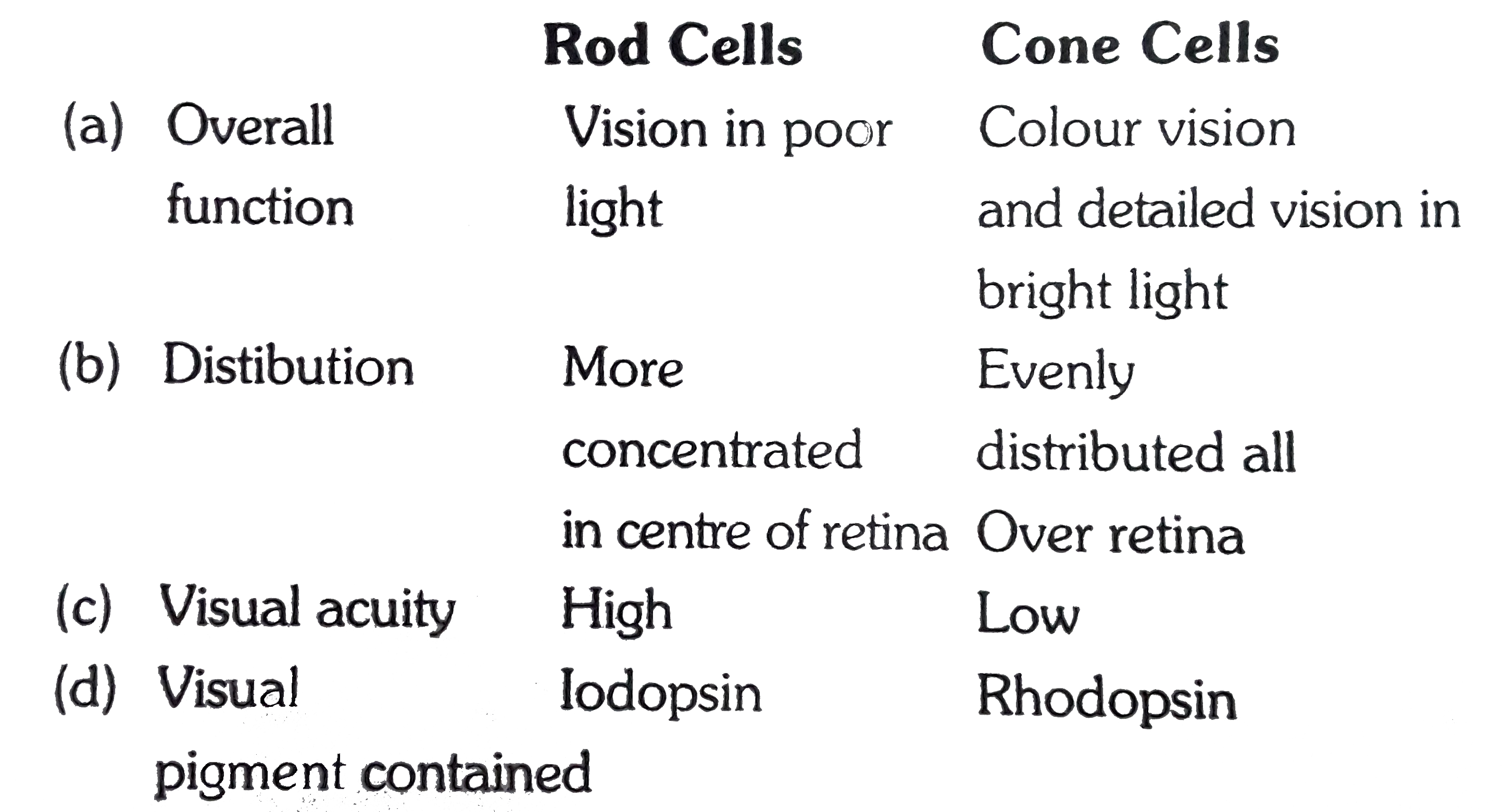What are rods and cones cells?
Step-by-Step Solution:
1. Definition of Rods and Cones:
- Rods and cones are specialized photoreceptor cells located in the retina of the human eye.
2. Function of Rod Cells:
- Rod cells are primarily responsible for vision in low light conditions, which is known as scotopic vision. They are highly sensitive to light and allow us to see in dimly lit environments.
3. Function of Cone Cells:
- Cone cells function in brighter light conditions and are responsible for photopic vision. They enable color vision, allowing us to perceive different colors.
4. Comparison of Rods and Cones:
- Rods are more numerous than cones and are more sensitive to light, making them essential for night vision. In contrast, cones are less sensitive but are crucial for detecting color and detail in well-lit conditions.
5. Location:
- Both rod and cone cells are located in the retina, which is the light-sensitive layer at the back of the eye.
Summary:
Rods and cones are photoreceptor cells in the retina. Rods are responsible for vision in low light (scotopic vision), while cones are active in bright light and enable color vision (photopic vision).
---
- Rods and cones are specialized photoreceptor cells located in the retina of the human eye.
- Rod cells are primarily responsible for vision in low light conditions, which is known as scotopic vision. They are highly sensitive to light and allow us to see in dimly lit environments.
- Cone cells function in brighter light conditions and are responsible for photopic vision. They enable color vision, allowing us to perceive different colors.
- Rods are more numerous than cones and are more sensitive to light, making them essential for night vision. In contrast, cones are less sensitive but are crucial for detecting color and detail in well-lit conditions.
- Both rod and cone cells are located in the retina, which is the light-sensitive layer at the back of the eye.
Rods and cones are photoreceptor cells in the retina. Rods are responsible for vision in low light (scotopic vision), while cones are active in bright light and enable color vision (photopic vision).
Topper's Solved these Questions
- BOOK - MODERN PUBLICATIONCHAPTER - NEURAL CONTROL AND COORDINATIONEXERCISE - REVISION EXERCISES (Long Answer Questions)3videos
NEURAL CONTROL AND COORDINATION
- BOOK - MODERN PUBLICATIONCHAPTER - NEURAL CONTROL AND COORDINATIONEXERCISE - COMPETITION FILE (OBJECTIVE TYPE QUESTIONS)(A. MULTIPLE CHOICE QUESTIONS)131videos
NEURAL CONTROL AND COORDINATION
- BOOK - MODERN PUBLICATIONCHAPTER - NEURAL CONTROL AND COORDINATIONEXERCISE - REVISION EXERCISES (Very Short Answer Questions)24videos
NEURAL CONTROL AND COORDINATION
- BOOK - MODERN PUBLICATIONCHAPTER - MORPHOLOGY OF FLOWERING PLANTS EXERCISE - CASE BASED SHORT ANSWER TYPE QUESTIONS2videos
MORPHOLOGY OF FLOWERING PLANTS
- BOOK - MODERN PUBLICATIONCHAPTER - PHOTOSYNTHESIS IN HIGHER PLANTSEXERCISE - CHAPTER PRACTICE TEST9videos
PHOTOSYNTHESIS IN HIGHER PLANTS
Similar Questions
Knowledge Check
- Question 1 - Select One
Which one of the following is the correct difference between rod cells and cone cells of our retina ?
ARod cellsCone cellsVision in poor lightColour vision and detailed vision in bright lightBRod cellsCone cellsMore concentrated in centre of retinaEvenly distributed all over retinaCRod cellsCone cellsLow in numberHigh in numberDRod cellsCone cellslodopsinRhodopsin - Question 2 - Select One
Area of retina devoid of rods and cones is
AYellow spotBBlind spotCBlue spotDBlack spot - Question 3 - Select One
Assertion :- Blind spot of the retina of the eye is devoid of the ability of vision.
Reason:- The photoreceptor rods & cone cells are absent in the blind spot.AIf both assertion and reason are true and reason is the correct explanation of assertion.BIf both assertion and reason are true but reason is not the correct explanation of assertionCIf assertion is true but reason is false.DIf both assertion and reason are false.
Which one of the following is the correct difference between Rod Cells and cone cells of our retina
 View Solution
View SolutionDifferentiate between rods and cones of retina.
View SolutionIn human eye various type of photoreceptor cells are present like rods and cones. Choose the correct statement responsible for production of white light sensation ?
View SolutionSelect the correct statement regarding rods and cones in the human eye:
View SolutionSelect the correct statement regarding rods and cones in the human eye.
View Solution


